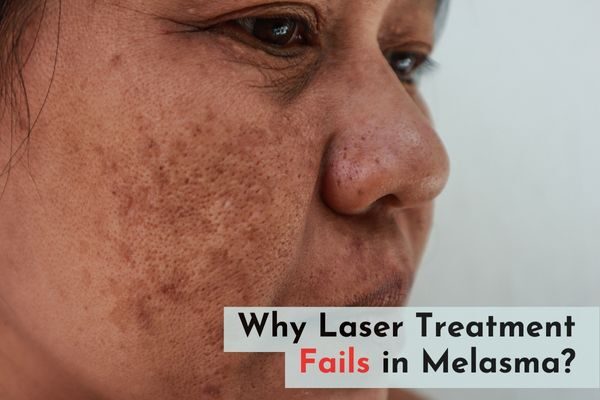
Melasma is a common skin condition characterized by dark, patchy discoloration on the face, particularly on the cheeks, forehead, upper lip, and chin. It predominantly affects women, although men can also develop it. The exact cause of melasma is still not fully understood, but it is believed to be influenced by hormonal changes, sun exposure, and genetic predisposition. Hormonal factors, such as pregnancy, hormonal medications, or hormonal imbalances, can trigger melasma or worsen existing patches. Sun exposure is another significant factor as ultraviolet (UV) rays stimulate the production of melanin, the pigment responsible for skin color. Melasma often becomes more pronounced during the summer months or after excessive sun exposure.
Causes for failure of laser treatment
Laser treatment has been widely used for various dermatological conditions, including melasma. However, it is important to note that while laser treatment can be effective for some individuals with melasma, it may not always produce satisfactory results or lead to complete resolution of the condition. There are several reasons why laser treatment may fail in treating melasma:

- Complexity of Melasma
Melasma is a complex skin condition characterized by the development of brown or grayish-brown patches on the face. It is thought to be caused by a combination of genetic, hormonal, and environmental factors. Melasma involves the overproduction of melanin, the pigment responsible for skin coloration, and the excessive deposition of melanin in the deeper layers of the skin. Treating melasma requires targeting melanin overproduction and dispersion, which can be challenging. - Depth of Melanin
Melasma pigment is often present deep within the skin, making it difficult for laser energy to reach and effectively break down the pigmented cells. Lasers typically work by emitting specific wavelengths of light that target melanin. However, the penetration depth of laser energy is limited, and if the melanin is located beyond the reach of the laser, the treatment may not be able to effectively target and remove the pigmentation. - Variable Response
Melasma is known to be a relapsing condition, meaning it can recur even after successful treatment. This variability in response to treatment can make it challenging to achieve long-term results with laser therapy alone. Factors such as sun exposure, hormonal changes, and certain medications can trigger melasma recurrence, and laser treatment alone may not address these underlying factors. - Melanin Reactivity
In some cases, melasma pigmentation can be more resistant to laser treatment due to the reactivity of melanin to laser energy. The melanin in melasma is often more active and reactive than normal skin pigment, leading to increased absorption of laser energy and potentially causing post-inflammatory hyperpigmentation (PIH). PIH is a common side effect of laser treatment, where the treated areas become darker or develop new pigmentation as a response to the laser energy. - Maintenance and Sun Protection
Laser treatment for melasma typically requires multiple sessions spaced apart. However, without proper maintenance and sun protection measures, melasma can return or worsen between treatment sessions. Sun exposure is a known trigger for melasma, and failure to protect the skin from UV radiation can compromise the effectiveness of laser treatment.
Conclusion
It is important to note that the effectiveness of laser treatment for melasma can vary greatly depending on the individual’s skin type, the type of laser used, the skill and experience of the treating doctor, and the patient’s commitment to post-treatment care. In many cases, a combination approach involving lasers, topical medications, and strict sun protection measures may be necessary for optimal results in managing melasma. Consulting with a dermatologist in South Delhi or a skincare professional is essential to determine the most appropriate treatment plan for each individual.
